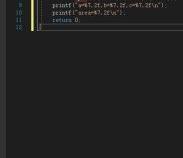go语言如何构建一个微服务
发布时间:2025-03-03 12:17:44 发布人:远客网络

要编写一个Go语言的服务,可以按照以下步骤进行:1、编写一个简单的HTTP服务器,2、定义路由和处理程序,3、启动并测试服务器。下面将详细描述第一步:
1、编写一个简单的HTTP服务器:我们需要导入net/http包并编写一个基本的HTTP服务器。这个服务器将监听指定的端口并响应HTTP请求。具体代码如下:
package main
import (
"fmt"
"net/http"
)
func helloHandler(w http.ResponseWriter, r *http.Request) {
fmt.Fprintf(w, "Hello, World!")
}
func main() {
http.HandleFunc("/", helloHandler)
fmt.Println("Server is listening on port 8080...")
http.ListenAndServe(":8080", nil)
}
一、编写一个简单的HTTP服务器
在开始之前,确保你已经安装了Go编程环境。如果没有安装,可以访问Go官网进行下载和安装。
-
导入必要的包:
net/http: 这个包提供了HTTP客户端和服务器的实现。fmt: 这个包提供了格式化I/O函数。
-
定义处理程序函数:
helloHandler函数将处理所有进入的HTTP请求。在这个例子中,它简单地返回“Hello, World!”字符串。
-
设置路由和启动服务器:
- 使用
http.HandleFunc函数来关联URL路径和处理程序函数。 - 使用
http.ListenAndServe函数来启动服务器并监听指定的端口(这里是8080)。
- 使用
二、定义路由和处理程序
为了扩展服务,可以定义多个路由和处理程序。以下是一个例子,展示了如何添加更多的处理程序和路由:
package main
import (
"fmt"
"net/http"
)
func helloHandler(w http.ResponseWriter, r *http.Request) {
fmt.Fprintf(w, "Hello, World!")
}
func goodbyeHandler(w http.ResponseWriter, r *http.Request) {
fmt.Fprintf(w, "Goodbye, World!")
}
func main() {
http.HandleFunc("/hello", helloHandler)
http.HandleFunc("/goodbye", goodbyeHandler)
fmt.Println("Server is listening on port 8080...")
http.ListenAndServe(":8080", nil)
}
-
定义更多的处理程序函数:
goodbyeHandler函数将处理/goodbye路径的HTTP请求。
-
设置更多的路由:
- 使用
http.HandleFunc函数来关联不同的URL路径和处理程序函数。
- 使用
三、启动并测试服务器
一旦你编写了HTTP服务器的代码,就可以启动并测试它。以下是一些步骤和建议:
-
启动服务器:
- 打开终端并导航到包含服务器代码的目录。
- 运行
go run main.go命令启动服务器。
-
测试服务器:
- 打开浏览器并访问
http://localhost:8080/hello,你应该看到“Hello, World!”。 - 访问
http://localhost:8080/goodbye,你应该看到“Goodbye, World!”。
- 打开浏览器并访问
-
使用curl命令行工具测试:
- 运行
curl http://localhost:8080/hello,你应该看到“Hello, World!”。 - 运行
curl http://localhost:8080/goodbye,你应该看到“Goodbye, World!”。
- 运行
四、处理更多的HTTP方法和中间件
在实际应用中,你可能需要处理更多的HTTP方法(如GET、POST、PUT、DELETE等)以及使用中间件。以下是一个例子,展示了如何处理POST请求和使用中间件:
package main
import (
"fmt"
"net/http"
)
func helloHandler(w http.ResponseWriter, r *http.Request) {
if r.Method == http.MethodGet {
fmt.Fprintf(w, "Hello, GET!")
} else if r.Method == http.MethodPost {
fmt.Fprintf(w, "Hello, POST!")
} else {
http.Error(w, "Method not allowed", http.StatusMethodNotAllowed)
}
}
func loggingMiddleware(next http.Handler) http.Handler {
return http.HandlerFunc(func(w http.ResponseWriter, r *http.Request) {
fmt.Printf("Received %s request for %sn", r.Method, r.URL.Path)
next.ServeHTTP(w, r)
})
}
func main() {
helloHandlerWithMiddleware := loggingMiddleware(http.HandlerFunc(helloHandler))
http.Handle("/hello", helloHandlerWithMiddleware)
fmt.Println("Server is listening on port 8080...")
http.ListenAndServe(":8080", nil)
}
-
处理不同的HTTP方法:
- 在
helloHandler函数中,根据请求的方法(r.Method)来处理不同的HTTP方法。
- 在
-
定义中间件:
loggingMiddleware函数是一个中间件,它在处理请求之前打印请求方法和URL路径。
-
使用中间件:
- 使用
loggingMiddleware函数包装helloHandler处理程序,并将其关联到URL路径。
- 使用
五、使用第三方路由库(如gorilla/mux)
虽然net/http包提供了基本的路由功能,但在实际应用中,使用第三方路由库(如gorilla/mux)可以提供更强大的路由功能。以下是一个使用gorilla/mux库的例子:
package main
import (
"fmt"
"net/http"
"github.com/gorilla/mux"
)
func helloHandler(w http.ResponseWriter, r *http.Request) {
vars := mux.Vars(r)
name := vars["name"]
fmt.Fprintf(w, "Hello, %s!", name)
}
func main() {
r := mux.NewRouter()
r.HandleFunc("/hello/{name}", helloHandler).Methods("GET")
fmt.Println("Server is listening on port 8080...")
http.ListenAndServe(":8080", r)
}
-
导入
gorilla/mux包:- 安装
gorilla/mux包:运行go get -u github.com/gorilla/mux。
- 安装
-
定义路由:
- 使用
mux.NewRouter创建一个新的路由器。 - 使用
r.HandleFunc函数来关联URL路径和处理程序函数,并指定HTTP方法。
- 使用
-
启动服务器:
- 使用
http.ListenAndServe函数来启动服务器,并传递路由器r。
- 使用
总结,编写一个Go语言的服务主要包括定义处理程序函数、设置路由和启动服务器。通过这些步骤,你可以轻松创建一个基本的HTTP服务器。根据需要,你可以添加更多的处理程序、路由和中间件来扩展服务的功能。使用第三方路由库(如gorilla/mux)可以提供更强大的路由功能。进一步的建议包括:学习更多关于HTTP协议的知识,了解如何处理不同类型的请求数据,以及如何编写高性能和安全的Go语言服务。
更多问答FAQs:
1. Go语言中如何编写一个服务?
编写一个服务是Go语言中的常见任务,可以通过以下步骤完成:
步骤一:导入必要的包和库
你需要导入必要的包和库。例如,你可以使用net/http包来处理HTTP请求和响应。
步骤二:定义路由处理函数
你需要定义一个或多个路由处理函数。这些函数将负责处理不同的HTTP请求,并返回相应的响应。
步骤三:创建HTTP服务器
然后,你需要创建一个HTTP服务器,监听指定的端口,并将请求路由到相应的处理函数。
步骤四:启动服务
最后,你需要启动服务,让它开始监听HTTP请求并提供相应的功能。
以下是一个示例代码,演示了如何使用Go语言编写一个简单的HTTP服务:
package main
import (
"fmt"
"net/http"
)
func helloHandler(w http.ResponseWriter, r *http.Request) {
fmt.Fprint(w, "Hello, World!")
}
func main() {
http.HandleFunc("/", helloHandler)
http.ListenAndServe(":8080", nil)
}
以上代码定义了一个名为helloHandler的处理函数,它将在根路径上处理HTTP请求,并返回一个包含"Hello, World!"的响应。然后,main函数使用http.HandleFunc将helloHandler函数与根路径关联起来,最后通过http.ListenAndServe启动HTTP服务器,监听端口8080。
你可以根据自己的需求扩展这个示例代码,添加更多的路由处理函数和功能。




